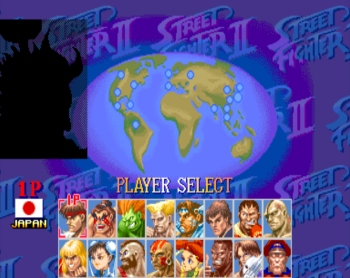
To select the crazy-overpowered hidden fighter, Akuma, stay on Ryu, T. Hawk, Guile, Cammy, and Ryu (again) for three seconds each then press all three punches and start.

Among many other things, the character portraits evolved from the very primitive artwork in World Warriors to the much superior and detailed artwork of New Challengers.

Across all five iterations of Street Fighter II, most characters received new special moves such as Chun-li’s Ascending Kick which actually stole the input from her old Spinning Bird Kick.
Review by Jay Wilson I considered reviewing all five iterations of Street Fighter II separately. However, I didn’t play each edition extensively; I tended to play every other version and just dabbled with everything in between. Then I considered reviewing the ones I played most, but once a new release came out I virtually never touched anything that came before it meaning I haven’t played vanilla SF2 in twenty years (nor do I care to revisit it either). So, ultimately I decided to regard World Warrior, Championship Edition, Hyper Fighting, and New Challengers collectively as a work in progress—rough drafts and revisions—with Super Turbo (SSF2T or ST) being the final copy eligible for a review. As hardware evolves, space constraints become relative nonissues allowing additional animation/sounds/voicework and 3D makes wacky camera angles possible, I can’t help but look back at Street Fighter II (and III) and long for that 2D sprite simplicity once again. No pre-fight introductions, short and to the point victory poses, no mini-cutscene Ultra Combos—press start, pick your character, and just fight until someone loses. Not to mention no stupid “story mode” or idiotic single player modes (a la Soul Calibur III) to trick simpletons who don’t want to play a multiplayer game into buying a multiplayer game. Single player in Street Fighter II consisted of fighting, fighting, and more fighting until the player reaches the boss and wins or gives up trying to beat the button reading CPU controlled opponents who don’t have to play by the rules (instant standing flash kicks, anyone?) And there’s something about the subtlety and abstractness of 90s fighting games that I miss too—that the only glimpses into a character’s personality is their moves and win poses, and the only hint of backstory/motive comes from watching their ending after beating arcade mode. Let’s be honest, most fighting game characters are caricatures. Look at Ryu, the stoic warrior in typical karate gi who lives solely for the fight. For his victory pose, he crosses his arms, bows his head, and lets his headband and black belt blow in the wind; in his ending, he doesn’t even show up to the victory ceremony, already searching for the next battle. That gets the point across just fine sans rival cutscene or anime prologue sequence. Or take Blanka, one of the sillier characters. A green monstrosity with wild red hair who rolls himself into a human (monstrous?) cannonball and hurls himself at his opponent. He thrusts his fists in the air and does a Star Wars sand-people victory roar, and upon beating the game—I kid you not—his mom shows up and we learn his real name is Jimmy and he was in a plane crash over the rain forest as a boy. Why he’s big, green, and conducts electricity through his skin, the game mercifully never tries to explain. Exploring this character in any degree of detail is a mistake. Plain and simple. But, if the game just sticks to him jumping on people and biting their head—you know, the fighting—we can tolerate him. Street Fighter II handles the personality traits of its cast with the grace of sledgehammer; technological improvements over the years hasn’t given the designers more tools, it’s given them bigger and bigger sledgehammers resulting in greater and greater overkill (see my Soul Calibur V review). Street Fighter never had nuanced character designs; it’s always been over the top so the less the better, and Street Fighter II mercifully has the least. 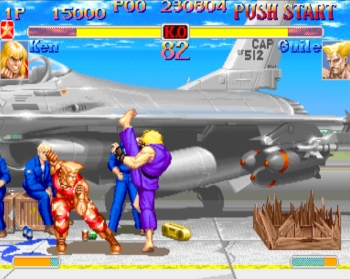
For the longest time, low guards defended against pretty much everything except air attacks and throws; Super Turbo introduced the Overheads (Ken’s axe-kick) which must be guarded high, making Turtling require some effort.

Three of the four bosses have different names in English and Japanese, so to minimize confusion they’re sometimes referred to as “claw,” “dictator,” and “boxer.”
On to the actual gameplay: Super Turbo offers seventeen total characters from different locations around the world (complete with their own stage and iconic background music). All seventeen are immediately accessible so the player does not have to screw around with tedious time wasting unlock requirements which would come to plague later console-exclusive fighters. All the characters play very differently even though they all use the same six buttons (three punches and three kicks of varying strengths/speeds). For example, characters can do a knockdown sweep by holding down and pressing Roundhouse, but each character has a specific animation with its own unique speed and range. Cammy and Guile being my favorites: the pigtailed Brit swings both her legs around like a gymnast on a pommel horse while the US Air Force Major sweeps once with each leg. Balrog (the boxer) has no kicks. Pressing any of the kick button yields another punch in essence giving him six different types of punches. And even though most characters fall into the category of “quarter-circle” or “charge” to execute their special moves, they still all play vastly different from one another due to the properties unique to each character and their respective specials. Blanka, Bison, and Honda all propel themselves across the screen by holding back for two seconds, tapping forward, and simultaneously hitting any punch button; but all three have different priorities, startups, hit boxes, active frames, recovery frames (among many other variables) which, in plain English, means Bison’s Psycho Crusher loses to Honda’s Headbutt Torpedo point blank but not at a distance. Thus, each move and special move becomes a tool in that character’s arsenal, specific to certain situations so even if the execution is identical the usage may be worlds apart. A more extreme example, Guile’s Sonic Boom (a projectile used to keep enemies at a distance) is performed using the same charge as Honda’s Headbutt (which is used to interrupt certain attacks and close distances). Even Ryu and Ken who both share a fireball, dragon punch, and hurricane kick with identical inputs play unique as Ryu’s moves tend to be single hit knockdowns while Ken is about multi-hit combos; Ryu’s fierce dragon punch knocks down on its one and only hit while Ken’s knocks down on the last of three hits. In other words, Ken’s reward for connecting with a fierce dragon punch could very well be receiving a deadly combo and losing the match if he doesn’t connect good enough. Ryu doesn’t have that problem. Across five revisions, players found glitches, gimmicks, and abusable techniques which helped the game evolve as developers responded by tweaking the properties of existing moves and introducing new moves into the characters’ arsenals to combat imbalances. So by the time Super Turbo came around, each character ended up with a rather refined moveset including pokes to keep opponents on their toes and chip away at their life, overheads for mixups which puts pressure on the defender, zoning attacks to keep opponents where you want them, airborne attacks that can double as evasive tactics, anti-air moves to shoot down incoming opponents (and help zone them too), and high damaging combos—all of which became the fundamentals of not just Street Fighter sequels/spinoffs but all fighting games. The underlying idea being that X beats Y which beats Z which beats X or, in other words, there is no universal win option. Everything can be beaten somehow. Player 1 has to respond to what Player 2 is doing and vice versa; the one who can adapt the fastest wins and wins consistently. The whole point of competitive gaming, after all, is to test player skill. 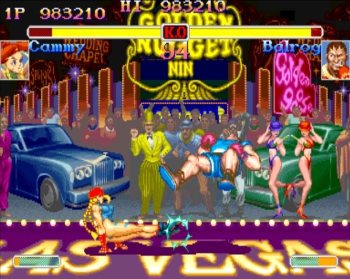
Championship Edition made the four bosses playable, Super SF2 introduced four new challengers, bringing the non-hidden character count up to sixteen.
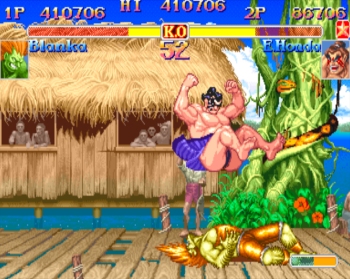
Notice Blanka doesn’t have a Super Meter. By inputting a code at the character select screen, you can choose the “old” (SSF2) version of a character.
Of course, no fighting game is perfectly balanced. Some characters are inevitably better than others, and some characters inevitably perform better in certain matchups. Balrog (Boxer), for example, is considered one of the best while T. Hawk is often regarded as one of the worst in the game. Then there’s sub-par E. Honda who can dominate characters who are technically better, but when he loses he loses bad (usually to anyone with a fireball.) But despite the gaps in character balance, a skilled and experienced Cammy player will beat out an amateur with pretty much any other character which means for the most part Super Turbo does its job (remarkably well, considering it came so early in the genre’s history.) I deliberately use the phrase “for the most part” because, for one, the hidden character Akuma is a universal win option; long story short, if Street Fighter were a game about tank combat, Akuma would be the Apache helicopter with Hellfire missiles. But let’s ignore him on the grounds that he’s a secret boss made playable for novelty. That aside, there is a fatal flaw with the very core of Super Street Fighter II Turbo: fireballs are way too powerful. They can be beaten, and beaten decisively (even by non-fireball characters for that matter), but depending on the matchup it can be an epic pain in the ass. And for the record, mindless tossing out fireballs isn’t really the problem. But if the fireball spammer has a modicum of skill and brains he can mix up the fireballs (most have three different speeds) with other moves (say, dragon punches or sweeps) which is incredibly easy to do and requires far more skill and precision to beat which, of course, leads to hordes of players launching fireball after fireball after bloody fireball because humanity excels at finding the least resistant path. And even if you can beat it, the monotony of the same attack pattern repeated on an infinite loop grows boring in a hurry. In 2008, Super Street Fighter II Turbo received an overhaul and re-release with much overhyped redrawn HD graphics that, to my dismay, are a mediocre, soulless, and sterile regurgitation of excellence that happens to have a higher pixel count. Quantity over quality. A gimmick at best, and certainly nothing praise worthy. Like the Gus Van Sant remake of Psycho. Shot for shot, but somehow lacking the charm of its source. The original Super Turbo graphics look and feel like the artists fought against hardware constraints to cram every last detail they could pack into the game. Comparing the low res original ST graphics with its competitors from the same era, I’m reminded how all artists struggle with the same things as they advance including the ability to rotate objects, properly foreshorten them when the perspective demands it, and the ability to make figures look natural in bold dynamic positions. Novice artists often stick to very flat renders that keep foreshortening to a minimum, their lack of experience translates to not knowing what to do with extremities and more often than not results in figures looking timid, static, awkward, and stiff. But check out Street Fighter II, and notice how its artists went out of their way to rotate and foreshorten their characters. Watch Bison, Cammy, and Dhalsim twist like torpedoes during their psycho crusher, cannon drill, and descending drill respectively; check out how Zangief leaps high into the air and rotates with his victim during his patented spinning pile driver; look at any of the numerous spinning kick moves (Chun li, Dee Jay, Fei Long, Ryu, Ken, and Akuma all have one); or heck, just press one button (Roundhouse) and count the number of characters who rotate their whole bodies to deliver the kick. These animations give the characters a sense of three dimensions—a sense of depth—sorely lacking in many other mid-90s fighters (and even some today). 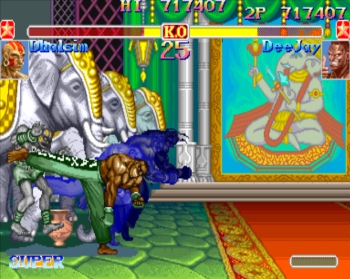
Offense builds the Super Meter (bottom corners of the screen) which allows the player to execute a Super Combo for massive damage.
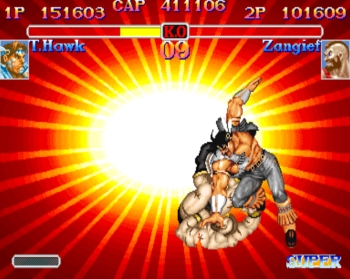
Finishing your opponent off with a Super Combo rewards you with a flashy star burst effect which, I think, packs more of a punch than the Mortal Kombat Fatalities.
Also notice how there’s a looseness to the Street Fighter II’s stances. Every frame, every pose, appears deliberate and functional even when the moves are impossible. Look at the above screenshot of Ken doing an axe kick, and observe that Ken has risen up on his toes so his heel is off the ground. Now notice his hand: his pinky and ring finger are curled up, but his middle finger and index finger are extended as if to help him maintain his balance. A lesser artist would have drawn his foot flat on the ground and all his fingers extended and/or his hand in a fist (which is kind of the inexperienced artist’s default hand positions even though the hand never goes to either by default.) It’s little details like this that are the difference between natural and stiff, between a weighted figure and one that floats, between Street Fighter II and World Heroes, Fatal Fury, and Art of Fighting. The notable exception? Samurai Shodown whose sprites do a fine job standing up to SF2’s. During Street Fighter II’s reign in the arcades, many other game developers created their own fighting games and built franchises around them, and I tried most of them (usually during my downtime with SF2.) What’s interesting is that even though it became something of a running joke that Capcom could not count to three—that the original Samurai Shodown, Mortal Kombat, Art of Fighting, and Fatal Fury (which came after SF2) managed to reach their magic numbered sequel before Street Fighter II—when everything is said and done SSF2T stands above all of them. I always returned to Street Fighter and, with the exception of Mortal Kombat, never looked back at any other 2D fighter nor do I have the desire to revisit them. Today, I much prefer Street Fighter III: Third Strike, but you know what? I could be persuaded to pop in Super Turbo and go a few rounds. | ||||||||||||||||||||
|
| ||||||||||||||||||||
